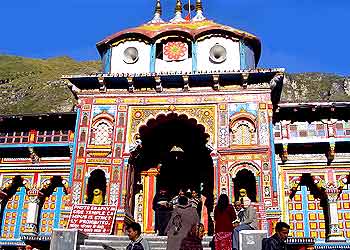|
Badarinath Dham is considered as one of the most
sacred centres of pilgrimage situated in the lofty Himalayan heights in
the Garhwal hill tracks (Uttarakhand). Situated at the height of 3133 m
(10248 feet) above sea level. The route to Badarinath is one of the most
fascinating one due to the lofty hilly terrain, curves and cliffs amidst
the most scenically beautiful place on the earth.
Throughout the route to Badarinath there are numerous pilgrimage sites
at Deo Prayag, Rudraprayag, Karnaprayag, Nandaprayag and Vishnuprayag;
as well as Pandukeswar where king Pandu observed Tapasya with his queen
Madri and where his sons Pandavas, stayed during their pilgrimage to
heaven, and the site where Bhima and Hanuman (sons of Vayu) met.
At Badarinath Lord MahaVishnu is believed to have done his penance.
Seeing the Lord doing his penance in the open, Goddess Mahalaxmi is
believed to have assumed the form of Badari tree to provide him shelter
to face the onslaught of the adverse weather conditions, therefore the
name Badari Narayan. It is believed that Lord Vishnu revealed to Narad
rishi that Nar & Naryans forms were his own. It is also believed that
Narad rishi, who also did his penance here, is even now worshipping the
supreme God with Ashtakshara mantras.
The image of Badarinarayan here is fashioned out of Saligramam.
Badarinarayan is seen under the Badari tree, flanked by Kuber and Garuda,
Narad, Narayan and Nar. Mahalakshmi has a sanctum outside in the
parikrama. There is also a shrine to Adi Sankara at Badarinath.
Behind the temple of Lord Badarinarayan is the Lakshmi Narsimh mandir,
with shrines to Desikacharya and Ramanujachary.At Badarinath one can
witness one of the greatest wonders of Nature in the Hot water springs
of Taptkund on the banks of ice chilled river Alaknanda. The temperature
of the water in the Kund is 55 degree centigrade whereas the normal
temperature in this region for most part of the year remains at 9-10
degree centigrade to sub-zero levels. Before visiting the temple the
pilgrims take a holy bath in the Taptkund.
The Temple's present structure was built by the Kings of Garhwal. The
Temple has three sections - Garbhagriha (Sanctum), the Darshan Mandap,
and Sabha Mandap. The Garbhagriha (Sanctum) houses Lord Badari Narayan,
Kuber (God of wealth), Narad rishi, Udhava, Nar & Narayan.
Lord Badari Narayan (also called as Badari Vishal) is armed with Shankh
(Conch) and Chakra in two arms in a lifted posture and two arms rested
on the lap in Yogamudra.The principal image is of black stone and it
represents Vishnu seated in meditative pose. The temple also houses
Garuda (Vehicle of Lord Narayan). Also here are the idols of Adi Shankar,
Swami Desikan and Shri Ramanujam. Guru-Shisya parampara is supposed to
have its roots here.
Kapat Opening:-
The Kapat of Shri Badrinath Temple is opened on 9th May 2008 at
7:50 AM.
Best Time to visit:- The ideal time
or peak season to go for a Char Dham Yatra is from May to October,
except monsoons. This is because; all the four sacred sites are perched
in Garhwal Himalayas, which is prone to heavy snowfall. As a result, all
the passage leading to the shrines are blocked. Moreover, during the
monsoon season, there is undue threat of having landslides, which can
further disrupt the journey. For safety reasons, the gates of the
temples are also closed for this period of time and the idols are
shifted to nearby pilgrim points.
Wallpapers / Images of Badrinath Temple
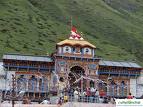
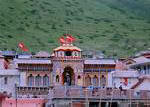
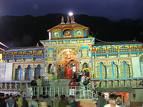
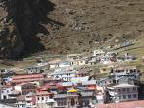
Location of Badrinath Temple
| Location |
: |
Right Bank River Alaknanda |
| Dedicated To |
: |
Lord Vishnu |
| Altitude |
: |
3,133 mt |
| Built In |
: |
8th Century AD |
Mythological Legend
Legend has it, when the Ganga was requested to descend to earth to
help suffering humanity, the earth was unable to withstand the force
of its descent. Therefore the mighty Ganaga was split into twelve holy
channels. Alaknanda was one of them that later became the abode of
Lord Vishnu or Badrinath.
The temple of Shri Badrinathji on the banks of the Alaknanda river,
dates back to the vedic times. Situated at an altitude of 3,133 mts.,
the present temple is believed to have been built by Adi Guru
Shankaracharya- an 8th century's philosopher-saint, who also
established a 'math' here. Also known as 'Vishal Badri', Badrinath is
one of the Panch Badris.
Panch Badris or Five Badris
Besides the main temple of Badrinath there are four other smaller
badri temples. These are collectively called the panch badris or five
badris. Very few pilgrims however, visit the other four Badri temples.
- Yogadhyan Badri (1920 m.)
Closest to the main temple of Badrinath lies this tiny, sleepy
hamlet which remains unnoticed by most pilgrims and is the
winter home for the idol at Badrinath. Pandukeshwar is also an
important archaeological site. Some years ago, four ancient
metal foils engraved with a description of several kings in the
region were discovered here. Believed to be over 1500 years old,
these foils are kept at Joshimath, 30 km downstream.
- Bhavishya Badri (2,744 m.)
The bhavishya or future badri is situated at Subain near Tapovan,
about 17 km east of Joshimath. According to Hindu belief, when
evil is on the rise in this world, the two mountains Nara and
Narayan at Badrinath will close up on each other and destroy the
route to the present Badrinath. This would also mark the end of
the present world and the beginning of a new one. Lord Badrinath
will then appear at the Bhavishya Badri temple and be worshipped
here instead of at the present one.
- Bridha Badri or the 'Old Badri'
Bridha Badri or the 'old Badri' is the third temple about 7 kms
short of Joshimath, on the main Rishikesh-Badrinath motor road
at Animath. It is believed that Badrinath was worshipped here
before its enshrinement by Shankaracharya at the main Badrinath
seat. The temple of Bridha Badri is open throughout the year.
- Adi Badri
Adi Badri is the farthest from the other four badris. It is
approachable from Karnaprayag by a motorable road enroute
Ranikhet. The temple complex has 16 small temples with intricate
carvings.
Seven of these temples belong to the late Gupta period. Local
tradition assigns these buildings to Shankaracharya. The main
temple is distinguished by a pyramid shaped raised platform,
with a black stone idol of Vishnu.
Attractions of the
Badrinath
- Badrinath Temple
On the right bank of Alaknanda lies the sacred spot
perched at an altitude of 3,133 metres above the sea
level. Encircled by a beautiful valley, the 15mtrs. High
temple is dedicated to Lord Vishnu, it is built in the
form of a cone with a small cupola of gilt bull and spire.
Built by Adi Guru Shankaracharya - the philosopher-saint
of the 8th century, the temple has been renovated several
times due to damage by avalanches. Its colourful 'Singh
Dwara' or the main entrance gate gives it a new, modern
look.
The temple divided into three parts - the 'garbha griba'
or sanctum sanctorum, the 'darshan mandap' where the
rituals are conducted and the 'sabha mandap'where devotees
assemble.The complex has 15 idols. Especially attractive
is the one metre high image of Badrinath, finely sculpted
in black stone. It represents Lord Vishnu seated in
meditative pose.
- Tapt Kund
Devotees take a holy dip in the natural thermal springs on
the banks of the river Alaknanda, before entering the
Badrinath Temple. The water of the kund is believed to
have medicinal properties.
- Hemkund Sahib (43 kms.)
Near the Valley of Flowers is the holy lake Hemkund- an
important pilgrimage of the Sikhs and Hindus. Along its
shores is the sacred Sikh Shrine where Guru Gobind Singh,
the tenth Guru unified with God after prolonged mediation
in his previous birth.
Nearby is the Lakshman Temple where Lakshman - the brother
of Lord Rama performed his penance. The reflection of
surrounding snow-clad peaks in its placid waters offers a
scenic sight.
- Brahma Kapal
A flat platform on the bank of river Alaknanda where
Hindus perform propitiating rites for their deceased
ancestors.
- Neelkanth
A Pyramidical-shaped snowy peak towering above Badrinath,
popularly known as the 'Garhwal Queen'.
- Mana Village (4 kms.)
Inhabited by Indo-Mangolian tribe, it is considered to be
the last Indian village before Tibet on this route. Nearby
are Vyas Gufa- the rock cave of saint Ved Vyas, the writer
of Mahabharata; Bhim Pul- a natural bridge over the
Saraswati river and Vasundhara Falls- a 122 mts. high
waterfall- all forming and important part of the
pilgrimage to Badrinath.
- Mata Murti Temple (3 kms.)
On the right bank of Alaknanda stands the temple dedicated
to the mother of Sri Badrinathji.
- Alka Puri (15 kms.)
The source of Alaknanda river from the glacier snouts of
Bhagirath- Kharak and Satopanth glaciers.
- Satopanth (25 kms.)
A three cornered lake with a circumference of about 1 km.,
situated at an elevation of 4,402 mts. above sea level. It
is named ater the Hindu triad- Brahma, Vishnu and Mahesh,
who are believed to occupy one corner each of the lake.
The trek is hazardous with dramatic landscapes. An
experienced guide is advisable. Govindghat (25 kms.)
The confluence of Alaknanda and Lakshman Ganga rivers. It
has an imposing Gurudwara named after Guru Gobind Singh.
- Joshimath (44 kms.)
The winter home of Shri Badrinathji is situated on the
slopes above the confluence of Alaknanda and Dhauliganga.
It is one of the four 'maths' established by Adi Guru
Shankaracharya.
- Panch Prayag
The five important confluences- Deoprayag, Nandprayag,
Rudraprayag, Karnaprayag and Vishuprayag, form the Panch
Prayag.
- Deoprayag
The confluence of Alaknanda and Bhagirathi rivers. Ancient
stone scriptures are found here. Important pilgrim spots
are Shiv Temple and Raghunath Temple.
- Rudraprayag
The confluence of Alaknanda and Mandakini rivers. The
temples of Rudranath and Chamunda Devi are noteworthy.
- Nandprayag
The confluence of Alaknanda and Mandakini rivers. The
Gopalji Temple is worth a visit.
- Karnaprayag
The confluence of Alaknanda and Pindar rivers with temples
of Uma and Karna.
- Vishnuprayag
The confluence of Alaknanda and Dhauliganga rivers. An
ancient temple of Lord Vishnu stands here by a pool called
Vishnu Kund.
- Srinagar
The old capital of Garhwal, it is an important cultural
and educational centre. Places to visit include Kamleshwar
and Kilkeshwar temples and the Shankar Math.
How to Reach There
- By Air
Nearest Airport is Jolly Grant (317 kms.)
- By Rail
Trains from Rishikesh (300 kms.), Kotdwar (327 kms.)
- By Road
Well connected to Rishikesh, Haridwar, Dehradun, Kotdwar
and other hill stations of Garhwal and Kumaon region.
|
|
|
